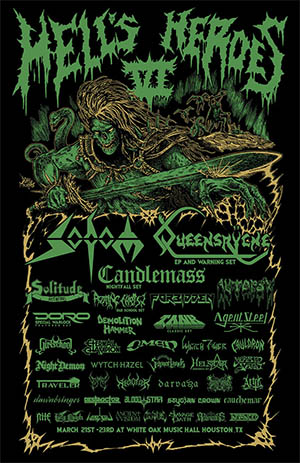Most people balk at spending more than $20 on a pair of headphones, given the disposable history of a typical portable consumer headphones for the past 35 years. Music lovers who do invest in a full size set of over-the ear cans, 9 times out of 10 they’re terrible sounding Beats or average sounding Bose noise reduction headphones. When flagships are selling for over $1,000, and more frequently more than $3,000, it’s understandable that the audiophile world can seem inaccessible to anyone but the most fervent hobbyists, obsessed music fiends, industry professionals, or just plain rich assholes with too much disposable income. However nearly every brand with a pricey flagship offers other more affordable models that benefit from the research and technology that go into the flagships. Case in point, the latest offering from venerable German company beyerdynamic, the DT 1990 Pro, which makes use of the Tesla technology first introduced to their T1 flagship in 2011. Tesla refers to the relatively large amount of magnetic force in the driver mechanism of the headphone which renders it very sensitive, and therefore efficient. The DT 1990 Pro is arguably a more accurate reference headphone than the T1, and at $600, less than half the current price of the updated T1 ($1,399). I also simply enjoy seeing images of new flagships, because they are often great looking works of art, much like loudspeakers and bicycles.
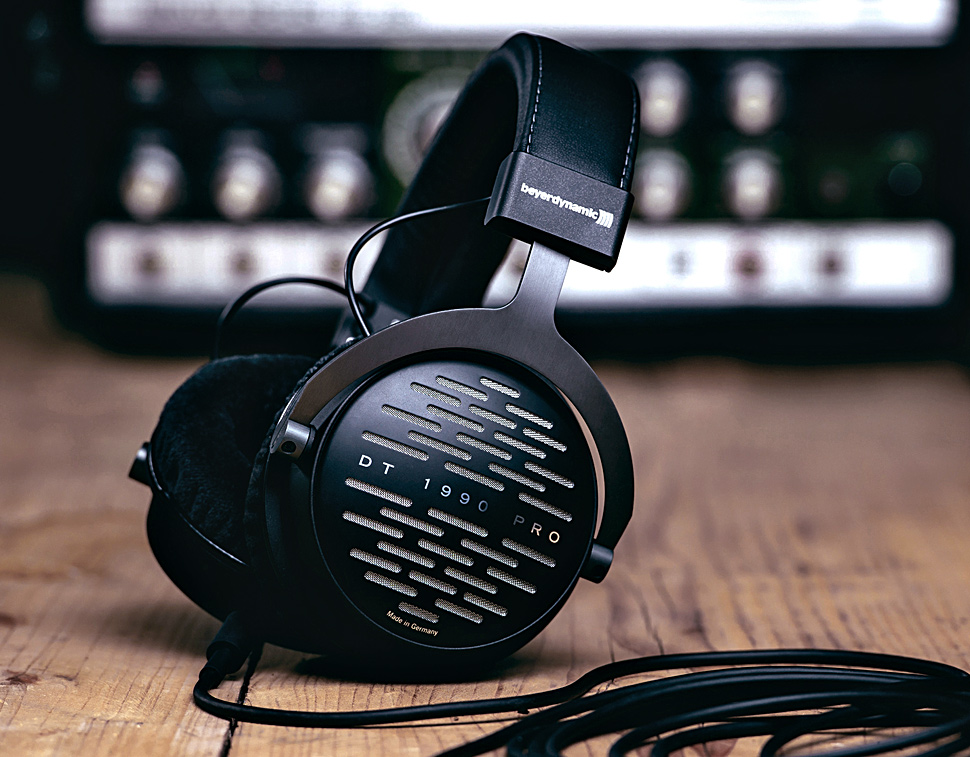
My love for headphones, as it is with many people, is rooted in a formative experience from my childhood. I grew up in an extended family of music lovers with pretty diverse record collections. However like a lot of sensible working class folks, they did not spend much money on fancy stereo systems. Well, my grandparents’ TV-record-player-shortwave-radio-bourbon-glass-storage combo might have been pricey for them back in the day, but it wasn’t exactly hi-fi. So the first time I put on my uncle’s full size Koss headphones (probably a 1974-76 model), I felt like I was in Oz when it flips to full color, or I’d fallen through the looking glass. I’d never heard music so intimately and with such detail before, and the experience played a big part in my becoming such an insatiable music fiend. Ironically my own headphone purchases started with an early cheap Sears knockoff of the Walkman, so basically the nadir of headphone history. It wasn’t until after college that I invested in a pair of Sony MDR-V6 to spare my housemates from my music late at night.
15 years later it was time to retire the worn out Sonys, and I joined the Head-Fi discussion forum to research what was new and exciting. I looked at the Sennheiser HD 650, beyerdynamic DT 880, Audio-Technica ATH-W1000, and Sony MDR-SA 5000 but went with AKG’s latest flagship the K701, which, remarkably cost less than half of their previous flagship the K1000 ($895) at $449, and I got it for $318. That was a decade ago, probably the last time a new flagship would debut at well under $1,000. The average price of flagship headphones has at least tripled since then, but I don’t really see that as a problem. It started with the Sony MDR-R10 in 1989, which sold for, $2,500, and then of course the 1991 Sennheiser Orpheus system, with the HE90 / and HEV90 tube amp, that originally sold for about $16,000, and went for up to $41,000 used (as there were only 300 made). Since 2009, flagships have regularly been coming out at between $1,800 and $6,000. And of course there’s the new Sennheiser Orpheus 2 HE1060/HEV1060 was revealed on November 3, 2015, at the price of $55,000. It rests on a solid marble base, when you turn it on the buttons come out, the tubes rise up (“and SLAY THEIR OPPRESSORS!” joked a friend when I posted this on FB), and the case opens revealing the headphones.
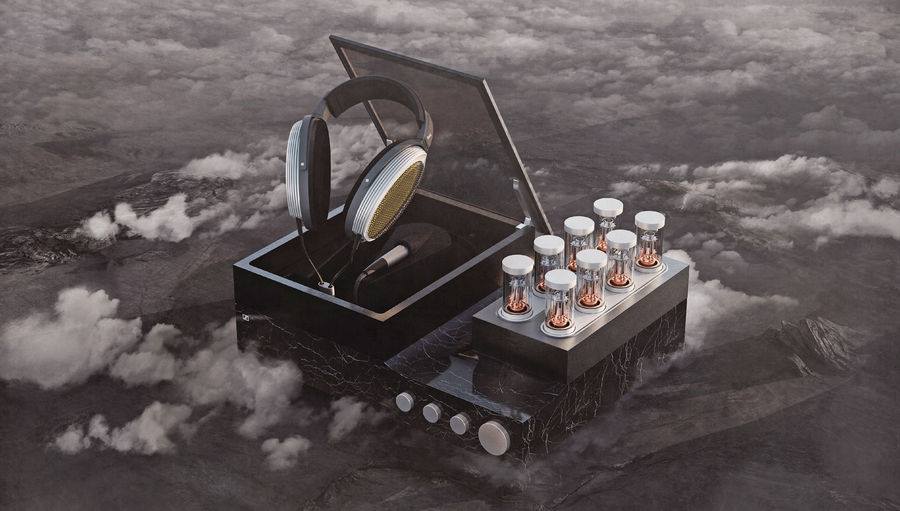
I’ve peripherally paid attention to the audiophile speaker industry, which remains much larger, with many, many more brands available, with literally dozens that sell for more than the cost of a luxury car, some even a house. They represent not a shift, but an expansion from consumer-oriented product, to limited edition benchmarks to show what all their research, technology and resources can come up with, unlimited by cost, just as many car manufacturers have their limited flagship models. I will never own most of these headphones, but regular people do get opportunities to try them out in listening rooms, Head-Fi meets and trade shows like CanJam London last month, and coming up, the 13th annual Rocky Mountain Audio Fest in Denver, October 7-9. There should be at least a couple new exciting flagships announced. I’m most excited to learn more about two new flagships from ZMF, which I will get back to at the end of the article.
It’s gratifying to see the growth and enthusiasm in this industry the past ten years, when so many are prematurely lamenting the alleged death of albums, CDs, and high fidelity. Clearly there are still many people who believe music is worth spending money on, both on the physical artifacts and the gear. And the fact is that the technology has been trickling down, so that many of the most inexpensive IEMs sound much better than they did previously. So while I may never own the new Focal (a French company that has made $180,000 loudspeakers) Utopia flagship introduced in June for $4,000, or Sony’s new flagship MDR-Z1R ($2,300), which will be available in October, headphones are improving all the time at all pricepoints.
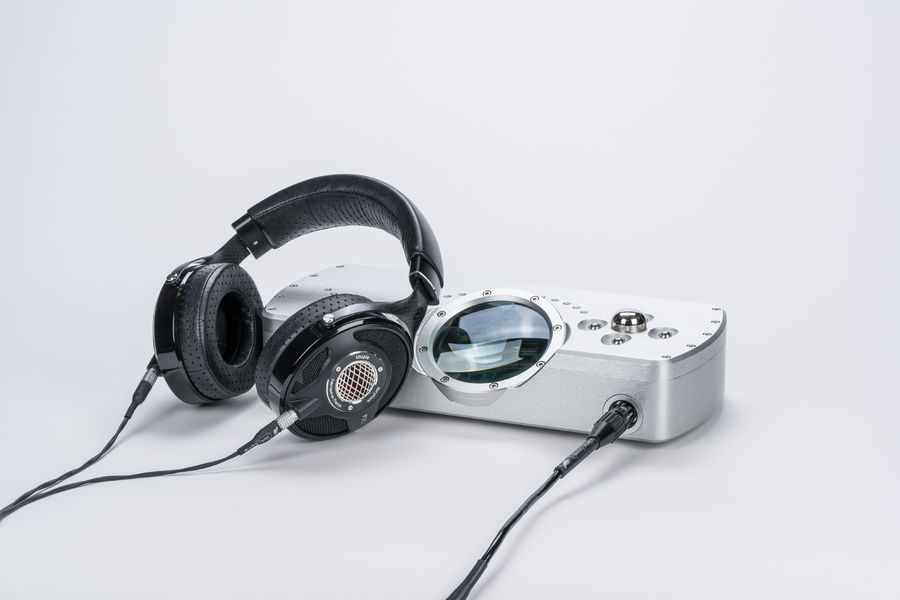
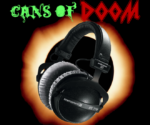 For example, beyerdynamic has trickled down the Tesla driver technology originally introduced in its T1 flagship into two of their arguably best headphones, the DT 1770 Pro closed headphone which came out last year, and the open DT 1990 Pro, out recently on September 19. I previously had a great run with the closed DT 770 Pro, as seen in “Cans Of Doom” in 2013, but sold it in order to try another open headphone, the Philips Fidelio X2, which I wrote about here.
For example, beyerdynamic has trickled down the Tesla driver technology originally introduced in its T1 flagship into two of their arguably best headphones, the DT 1770 Pro closed headphone which came out last year, and the open DT 1990 Pro, out recently on September 19. I previously had a great run with the closed DT 770 Pro, as seen in “Cans Of Doom” in 2013, but sold it in order to try another open headphone, the Philips Fidelio X2, which I wrote about here.
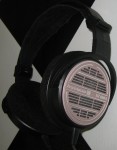 I decided I wanted a more neutral reference quality open headphone, and reviews indicated the DT 1770 Pro was exactly what I’d been looking for, and I ordered it just a couple days after it became available. Beyerdynamic certainly has an impressive history, starting in 1924, and creating the first dynamic headphones in 1937, the DT48, which stayed on the market for an amazing 75 years. They experimented with quadrophonic headphones in 1973, electrostatic in 1976, and in 1980, did what they did best in making another great dynamic headphone, the DT 880, which they claimed competed with the best of the latest electrostatic headphones. They may have been right, and that model still remains in production 36 years later. Beyerdynamic clearly know what they’re doing. They intended the closed back DT 770 Pro for studio and stage use, the semi-open back DT 880 Pro for reference monitoring, mastering and mixing, and the fully open back DT 990 Pro for critical listening.
I decided I wanted a more neutral reference quality open headphone, and reviews indicated the DT 1770 Pro was exactly what I’d been looking for, and I ordered it just a couple days after it became available. Beyerdynamic certainly has an impressive history, starting in 1924, and creating the first dynamic headphones in 1937, the DT48, which stayed on the market for an amazing 75 years. They experimented with quadrophonic headphones in 1973, electrostatic in 1976, and in 1980, did what they did best in making another great dynamic headphone, the DT 880, which they claimed competed with the best of the latest electrostatic headphones. They may have been right, and that model still remains in production 36 years later. Beyerdynamic clearly know what they’re doing. They intended the closed back DT 770 Pro for studio and stage use, the semi-open back DT 880 Pro for reference monitoring, mastering and mixing, and the fully open back DT 990 Pro for critical listening.
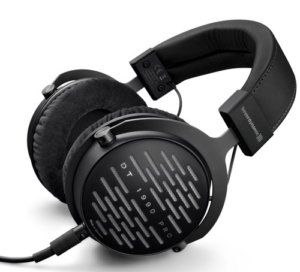 My DT 1990 Pro was delivered ahead of schedule last Saturday morning, and I was pleased right away with it’s look and feel. They had the sturdy build similar to the DT 770 Pro, but with slightly more heft (370 g vs the extremely light 270 g DT 770 that is ideal for musicians in action). The cable is removable, and both straight and coiled cables are provided. They also give two options for velour earpads, one for analytical listening and another that’s balanced with slightly more emphasized bass and rolled off treble. The pads seem a bit softer and more comfortable than the 770 Pro, and my AKG K701. I cannot emphasize enough how important it is to me that these are velour, and not leather or lambskin. I don’t care if they feel like your ears are being cuddled by tiny baby otters, I would never buy headphones that don’t at least give a non-animal skin options. So I will never own a Focal as long as they use lambskin, but kudos to companies like Audeze (who offer vegan pads) and beyerdynamic.
My DT 1990 Pro was delivered ahead of schedule last Saturday morning, and I was pleased right away with it’s look and feel. They had the sturdy build similar to the DT 770 Pro, but with slightly more heft (370 g vs the extremely light 270 g DT 770 that is ideal for musicians in action). The cable is removable, and both straight and coiled cables are provided. They also give two options for velour earpads, one for analytical listening and another that’s balanced with slightly more emphasized bass and rolled off treble. The pads seem a bit softer and more comfortable than the 770 Pro, and my AKG K701. I cannot emphasize enough how important it is to me that these are velour, and not leather or lambskin. I don’t care if they feel like your ears are being cuddled by tiny baby otters, I would never buy headphones that don’t at least give a non-animal skin options. So I will never own a Focal as long as they use lambskin, but kudos to companies like Audeze (who offer vegan pads) and beyerdynamic.
While the model number indicates it’s a successor to the DT 990 Pro, I wonder if it means something special that the Star Wars death star-patterned grill harks back to the 880. While there is more clamping force on the Pro series than consumer due to practical purposes, it’s still plenty comfortable, and I experienced no physical fatigue in my 2 to 4 hour session. I wondered if I would miss the lack of bass emphasis, but the truth is that there is plenty of bass, just as it was intended. It simply doesn’t artificially increase the bass like some other headphones.
The closed DT 1770 Pro does reportedly offer more bass, just like my Fostex TH-X00 and Denon AH-D2000 do. There’s nothing wrong with that, as the bass is naturally emphasized in a lot of live performances. Criticisms of the treble being somewhat annoying in previous models appears to have been solved in the 1990. The result is truly the most transparent, neutral sounding open headphones I’ve ever owned, the kind of headphone that makes you forget you’re wearing a headphone, and are just fully immersed in the music. I’ve sampled plenty of other headphones, but I have not personally experienced anything that has done this better. From what I have read, the EnigmaAcoustics Dharma D1000 ($1,190), OPPO PM-1 ($1,200), Mrspeakers Ether Flow ($1,800) and Focal Utopia ($3,999) are likely candidates to surpass it. So nothing else close in that price range except possibly the Audioquest Nighthawk ($599). I exclude the popular models from Audeze and HiFiMAN because they’re just so heavy (LCD-2 is 570, HE1000 V2 is 688 grams), that they are not a comfortable option if I want to listen for more than 30 minutes. While I will continue to switch to my Fostex TH-X00 to enjoy bass heavy rock and doom, the DT 1990 Pro should serve as an excellent reference for critical listening and reviewing music from all genres for years to come.
Historical Timeline
The history of significant advancements in headphone technology and important flagships has been grossly unrepresented, at least in any online articles I could find. Not only that, but they’re often just wrong, like implying that the Orpheus was introduced in the 90s at $41,000. This is far from complete, and I posted it on Head-Fi to get help in fact-checking. With just a week of research, it may not be perfect, but feel free to offer feedback.
Collect ’em all! Just kidding, please don’t. I’m sure there are people who have tried. The fact that headphones are generally more affordable and take up less space than full sized loudspeakers, does make them more easily collectible. While I do have a few sets up loudspeakers for different rooms, I intend to keep some of them for life. I keep my headphone inventory to six pairs. Two for reference in the Psychedelic Listening Lair/Doom Cave, and the rest in the living room for TV/movies, bedroom, at work, and one for commuting/travel. In 2012, David Mahler created an epic “Battle of the Flagships” thread on Head-Fi, reviewing over 50 headphones, most from his personal collection. He has pretty much disappeared from the forum, and I hope it’s because he scaled back and not went completely bankrupt and homeless! But I have to admit, many of these headphones are nearly as impressive to look at as they are to listen to.
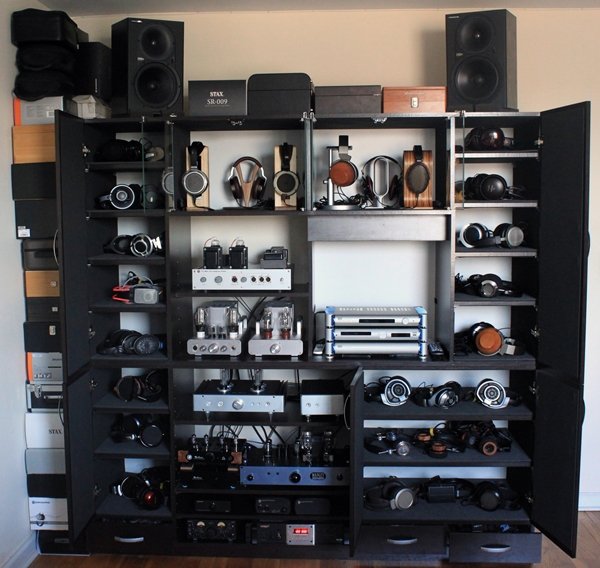
1924 beyerdynamic founded in Germany

1937 beyerdynamic DT48
The world’s first stereo dynamic headphones, remained in production until 2012. 75 years is the longest run ever for a headphone model.
1938 Stax Ltd. founded in Japan
1945 Sennheiser electronic GmbH & Co. KG founded in Germany by Fritz Sennheiser, who died in 2010.
1947 AKG Acoustics founded in Vienna, Austria.
1953 J.C. Koss Hospital Television Rental Company founded by John C. Koss in Milwaukee, Wisconsin.
1953 Grado Labs founded in Brooklyn, New York.
1958 Koss SP3 Stereophones
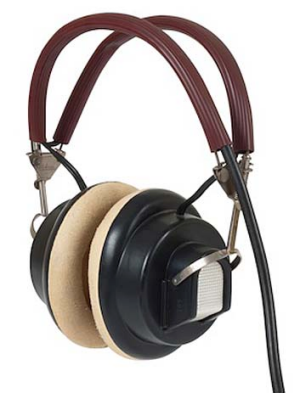 What made this product unique was the privacy switch feature, which gave listeners the opportunity to listen to the first Koss SP3 Stereophones. Initially, the products purpose was to demonstrate to consumers the high-fidelity stereo sound of the portable phonograph. Prior to this time, headphones had only been used for communications purposes. In 1958, the design was debuted at a hi-fi trade show in Milwaukee, and audiences were approving of the design. Soon after the trade show, Koss went into business manufacturing and marketing stereophones from his basement apartment. The technology was imitated by competing manufacturers, which set the design and aesthetics of headphones for years to come
What made this product unique was the privacy switch feature, which gave listeners the opportunity to listen to the first Koss SP3 Stereophones. Initially, the products purpose was to demonstrate to consumers the high-fidelity stereo sound of the portable phonograph. Prior to this time, headphones had only been used for communications purposes. In 1958, the design was debuted at a hi-fi trade show in Milwaukee, and audiences were approving of the design. Soon after the trade show, Koss went into business manufacturing and marketing stereophones from his basement apartment. The technology was imitated by competing manufacturers, which set the design and aesthetics of headphones for years to come
1959 AKG K50 model, the world’s first supra-aural and open-back headphones.
1960 Stax SR-1, their first electrostatic earspeaker debuts.
This may be the first electrostatic headphone on the market.
1962 Audio-Technica Corporation established by Hideo Matsushita in Tokyo, Japan.
1968 Koss ESP/6, the first self-energizing electrostatic stereophone.
 1968 Sennheiser HD414, the world’s first open headphones.
1968 Sennheiser HD414, the world’s first open headphones.
The history of audiophile sound began with the HD 414. The world’s first open headphones revolutionized the headphones market in 1968. For the first time, the ears could hear in a way that they are accustomed to: open and free in space. The sound could travel to the ear drum much more naturally and clearly than in the closed models which were available at that time. With its new principle, the HD 414 triggered an absolute boom in headphones sales. More than 100,000 sets of headphones had already been sold by the end of 1969. It remains one of the best-selling headphone models in the world, with a total of over 10 million units sold.
1973 Fostex founded in Japan
1973 beyerdynamic DT 204 quadrophonic headphone
1974 Audio-Technica AT700
1974 Koss HV1A, the first dynamic stereophone to deliver all 10 audible octaves
1974 Pioneer SE-700, very unique high polymer, piezo-electric headphone
 1975 Yamaha HP-1, Yamaha’s first orthodynamic headphones.
1975 Yamaha HP-1, Yamaha’s first orthodynamic headphones.
For the next 15 years, orthodynamic or magnar planar would be quite popular, produced by Audio-Technica, Radio Shack, Pacific Stereo, Lafayette, Bang & Olufsen, Burwen, Wharfedale, Toshiba and Stax. But Yamaha may have sold more than the rest combined due to their consistent marketing and production, including subsequent lines, the YH-1, YH-100 and YHD-1. This doesn’t include their two flagships introduced in 1978 and 1981.
1976 beyerdynamic ET 1000, the first electrostatic headphones in Germany
1976 Sony ECR-500 electrolet
1976 Toshiba Aurex HR-910, electrolet headphones.
1977 Fostex T50RP
This inexpensive headphone (around $100) became hugely popular for customization hobbyists, and began the company’s tradition as an OEM provider for others, such as the NAD RP18, Maior RPT-50 and Lafayette RP 50. MrSpeakers got their start by modifying this line into the Alpha Dog and Alpha Prime using ground-breaking 3D printed cups, while ZMF uses wood cups for their line.
1977 Sennheiser Unipolar 2000 first open-back electret headphones
A further milestone followed when Sennheiser engineers combined the principle of open headphones with that of electrostatic transducer technology for the first time. Sennheiser’s launch of the Unipolar 2000 model in 1977 caused a sensation in the audio world. Its principle was once again an innovation in audio technology. In the electrostatic transducer, a high voltage is applied to two mesh-like electrodes. Just like in a loudspeaker, this voltage causes a coated foil diaphragm to vibrate in time with the audio signal. This results in an extremely fine resolution and low total harmonic distortion. “Its frequency curve has a relatively deep curvature from 2 to 4 kHz. This is one of the reasons why these headphones generate an extremely spacious, detailed, transparent, airy and nevertheless powerful sound image in unprecedented quality,” was how audio magazine ‘Hifi-Stereofonie’ sang the praises of the new headphones.
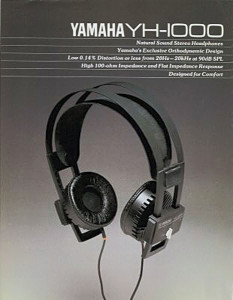 1978 Yamaha YH-1000 orthodynamic headphones
1978 Yamaha YH-1000 orthodynamic headphones
Yamaha’s exclusive Orthodynamic Design, a concept radically different from conventional dynamic or electrostatic types. Instead of an ordinary voice coil and diaphragm, it uses an ultra thin, low mass, polyester film diaphragm, sandwiched by a pair of powerful disc magnets. The voice coils are photo-etched on the surface of the diaphragm. The performance that results is marked by smooth, even response over the entire audible frequency range, low distortion, and clear imaging. They now sell for $1,500 on the used market.
1979 Stax SR-Lambda, Semi-panoramic sound type Earspeakers.
1980 beyerdynamic DT 880
For the first time according to beyerdynamic, dynamic headphones can compete with the performance of electrostatic headphones. 36 years later it’s still in production, $249.
1981 Sony ECR-800 electrolet, $550
1981 Yamaha YH-100 orthodynamic headphones.
Yamaha’s previous flagship’s run was very brief, perhaps because they were expensive (I can’t seem to find exactly how much they sold for) and people were not ready to pay that much. So the YH-100 was cheaper.
1984 Koss Porta Pro Release, portable “high-end supra-aural stereophone model”
1985 beyerdynamic DT 990
Premium Line headphones which feature a so-called “diffuse-field equalized” frequency response are suited for audiophiles.
1985 Sony MDR-V6
The headphones were listed as having a very wide frequency response and were convenient for travel as they could be folded and carried in an included leatherette bag. In 1987, audio industry journalist Daniel Kumin wrote, “Throw away your loudspeakers. There is now what may be the most perfect transducer yet made by man. Recently I auditioned a pair of Sony MDR-V6 Studio Monitor headphones, then purchased them. There are not enough superlatives in the dictionary to describe the performance of these headphones. Listening to them with a good CD recording is like being in the center of a live performance.” They remained in production for over 30 years.
1987 Stax SR-Lambda Signature T1 electrostatic earspeakers, $2,000
Included a tube amp.
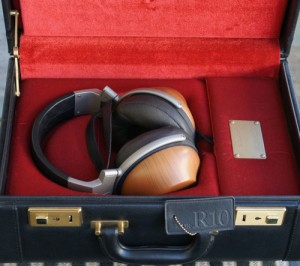 1989 Sony MDR-R10, $2,500
1989 Sony MDR-R10, $2,500
Sony’s groundbreaking flagship was $1,000 more than the previous flagships. The build quality and care was unprecedented. The most striking feature is the unique ear cup, a compound-curve sculpture machined from 200-year-old Aizu Zelkova wood. The wood was chosen for its light weight, hardness and sound transfer-ability. The cavity of the cup was set to create three dimensional sound expansions much like a concert hall. The earpads were lambskin and headband was made from a carbon fiber composite. The cable was crafted from LC-OFC copper insulated with soft silicon with an outer wrap being pure double-woven silk. A shape memory alloy was used to remove the need for adjustments and magnesium hangers between the ear pad and baffle plate prevented any mechanical vibrations to interfere with the sound quality. Even the unboxing experience was impressive. The headphones came in a well-crafted red-velvet lined, 8×11 lockable suitcase. A numbered certificate was also included.
 1990 AKG K1000, $895
1990 AKG K1000, $895
The K1000 were a unique design that is the equivalent of wearing a pair of loudspeakers on the head. The speaker capsule uses a unique, freely vibrating multilayer diaphragm driven by a newly developed, radially magnetized VLD (Ventilated Linear Dynamic) magnet system. Sitting in front of the ear, this dynamic transducer provides the best acoustic coverage factor. The earphones using no acoustically hard parts, the sound is absolutely free to develop in all its splendor. The speakers are acoustically finetuned in a computer-optimized process including time-energy distribution (Wigner distribution) measurements and made with advanced manufacturing techniques. The result was an unobstructed plane sound field in front of the ear that provides a personalized listening experience.
1990 Koss ESP-950 electrostatic with E-90 amp, $2,000
These are still being sold 26 years later, now for $1,000.
1991 Ultrasone AG founded in Tutzing, Germany
1991 Grado HP 1, $595
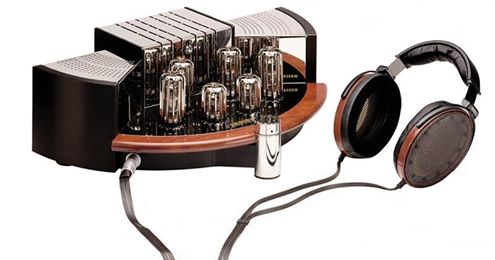
1991 Sennheiser HE90 / HEV90 Orpheus, $16,000
From a veritable flood of new headphones being introduced, one in particular stood out like a beacon in 1991: the electrostatic Orpheus. With the boldly ambitious mission to build the best headphones in the world, Sennheiser developers once again set to work – and once again exceeded all expectations of the audio sector with these electrostatic headphones and their impressive tube pre-amplifier. Two platinum-coated diaphragms vibrate between gold-coated glass electrodes. A 500 volt tube amplifier provides enough power to allow the Orpheus to fully unleash its sound. Due to the extremely complex technology involved, the Orpheus was produced in a limited edition of just 300 units. Original MSRP was about $16,000, and peaked at around $41,000 until the new Orpheus was introduced in 2015.
1993 Sony MDR-V600
Designed to satisfy DJs who wanted a greater emphasis on bass. To help DJs in cuing songs with one ear, the MDR-V600’s earcups can be swiveled around backwards.
1993 Sennnheiser HD 580
1993 Stax SR-Omega electrostatic, $6,000
1994 Senneiser HE60 / HEV70 (Baby Orpheus)
At $1,500, this was much more affordable than the Orpheus. However, there were a lot of criticisms of the amp, and production didn’t last long.
1995 Sennheiser HD 580 Jubilee, $450
1995 Stax Lamba Nova Signature System with SRM-T1W amp, $3,200
Electrostatic Earspeaker System with Vacuum output stage Driver Unit/selector
(SRM-T1W+Lambda Nova Signature).
1996 Grado RS1, $700
1997 Sennheiser HD 600, $400
This iteration was more successful than the HE60, and it was sold at the much more reasonable price. It remained extremely popular throughout the next decade, even after the HD 650 was introduced in 2006.
1998 Stax SR-007 Omega II series electrostatic, $1,800
2003 Grado PS-1, $2,000
2003 Audio-Technica ATH-L3000, $2,000
2004 Sony Qualia 010, $3,300
2004 Ultrasone Edition 7, $3,100
2005 HiFiMAN Electronics founded by Dr. Fang Bien in Tianjin, China
2005 Audio-Technica ATH-W5000, $1,200
2006 Sennheiser HD 650, $500
2006 AKG K701, $449
This may be the last time a prominent headphone company’s flagship headphone would be sold for $400, but available in the market for a relatively affordable price of under $300. It’s impressive that AKG chose to keep the price significantly lower than their previous flagship from 16 years ago. This is also the first pair of flagship headphones I ever owned (and still own).
2007 Taket H2, $2,350
2008 Audeze founded in USA
Sankar Thiagasamudram and Alexander Rosson met engineer Pete Uka who developed specialized flexible circuit materials for NASA. They quickly realized the material might be perfect for headphones. That’s when Dragoslav Colich, who has 30+ years’ experience in designing planar drivers, joined the team as CTO to create a limited run of the LCD-1 headphone for $400, featuring proprietary planar magnetic designs with extremely thin-film driver materials. Planars overcome many limitations inherent in typical cone drivers; lightweight diaphragms are faster and more responsive than heavier moving-coil or dome drivers. By 2010 they had the LCD-2 for about a grand.
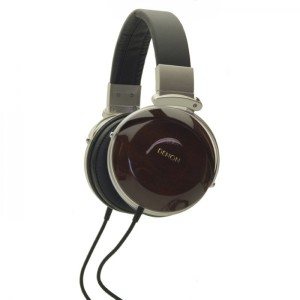 2008 Denon AH-D7000, $999.
2008 Denon AH-D7000, $999.
Designed by Fostex, the series would inspire fervent loyalty among a large group of headphone enthusiasts, even after production ended in 2012. Most of the properties which made the headphone great (solid bass without sacrificing much midrange, great for hard rock and metal) were also found in cheaper models, the D5000, D2000 and D1000. Lawton Audio exists solely to modify the cups in that series. Companies like Creative, E-Mu and Fostex itself continuing with the core design, and the Massdrop/Fostex collaborations on the TH-X00.
2009 Grado HP1000, $1,800
2009 Sennheiser HD800 flagship, $1,199
2010 HiFiMAN He 5, $599
2010 Ultrasone Edition 10, $2,749
2011 AKG K812, $1,299. So much for a cheap flagship!
2011 Audeze LCD-3, $1,995
2011 beyerdynamic T1 Tesla, $1,099
2011 HiFiMAN HE 500, $599
2011 Stax SR-009 electrostatic, $3,500
2012 HiFiMAN HE-6, $1,299
2012 Final Audio Design Muramasa VIII, stainless steel, 850g, $8,000
2012 Fostex TH900, $1,149
2013 JPS Labs Abyss AB-1266, $4,494 / $5,495
2014 Enigmatic Audio The Enigma, $900
2014 HiFiMAN HE 1000, $2,999
2014 Kennerton Odin, $2,250
2014 McIntosh MHP1000, $2,000
2014 OPPO PM-1 Planar Magnetic, $1,200
2014 Ultrasone Edition 5 limited edition, $4,999
2015 Audeze LCD-4, $3,995
2016 beyerdynamic T1 (2nd Gen), $1,399
2015 EnigmAcoustics Dharma D1000, $1,190
2015 Fostex TH900 Mk II, $1,505
2015 MrSpeakers Ether, $1,499
2015 Sennheiser Orpheus 2 HE1060/HEV1060, $55,000
2015 Pioneer SE-Master 1, $2,500
2016 Bowers & Wilkins P9 Signature, $900
2016 Focal Utopia, $4,000
2016 Mrspeakers Ether Flow, $1,800
2016 Sony MDR-Z1R, $2,300
2016 Ultrasone Tribute 7, $2,999
Coming Soon
2017 HiFiMAN Shangri-La
2017 LB-Acoustics Mysphere 3.1, by the team who created the AKG K1000
2017 Mrspeakers Ether ES Electrostatic [will be introduced at Rocky Mountain Audio Fest in Denver, October 7-9]
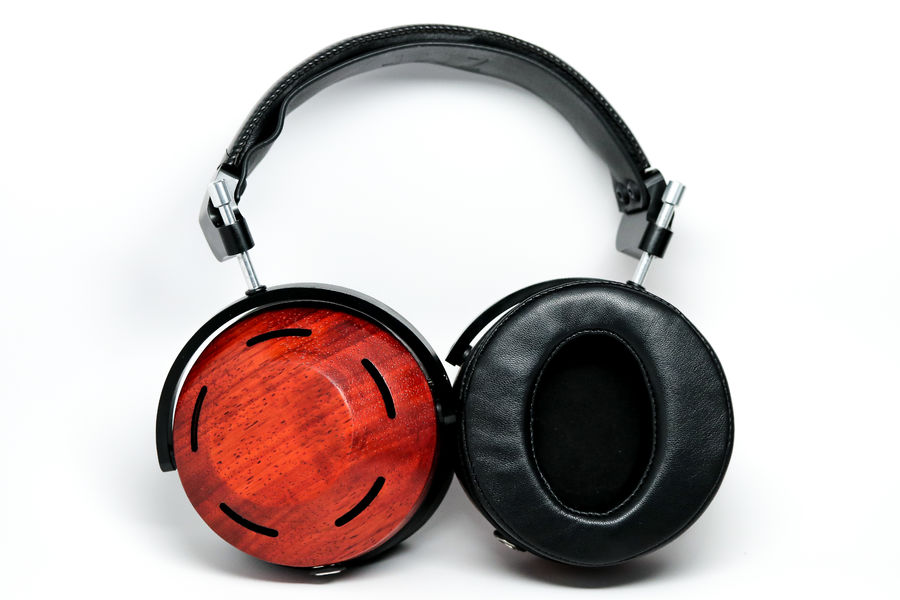
2017 ZMF Atticus ($999) & Eikon ($1,299)
Not one, but two new flagships from ZMF, will also show at RMAF. Like MrSpeakers, ZMF (a one-man show, Zach Mehrbach) got his start modifying the Fostex T50RP. A Head-Fi member who heard a prototype of the Eikon indicated a “HE-6/Abyss/TH900-level impact.” Both are 300 ohm semi-open, looking like a cross between the Sony MDR-R10 and ZMF Omni. The Atticus has a thermoplastic elastomer driver (TPE, like the Sennheiser HD 800), and the Eikon has a biocellulose driver, like the Sony R10 and Fostex TH900. They weigh about 500 g with cherry wood cups and 540 with padauk. More should be known after the RMAF. I just learned that Meherbach moved ZMF headquarters (e.g. his home) to my own hometown, Chicago. So after RMAF perhaps I’ll reach out to audition them or convince him to come to one of the local Head-Fi get-togethers.

August 15, 2022
Adventures in Vinyl
May 25, 2022
Rest in Pieces iPod Touch – Long Live the DAP
December 29, 2020
Budget Audiophilia
